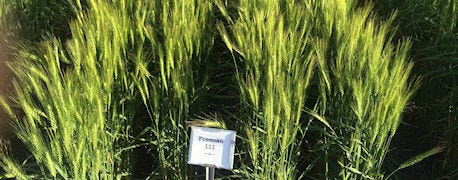September 12, 2014

Through a collaboration of USDA's Agriculture Research Service and the University of Nebraska, two new wheat varieties--Husker Genetics Freeman Brand and Husker Genetics Panhandle Brand--have been released for 2013-2014. Both varieties will have limited seed available this fall for planting. Husker Genetics Freeman Brand wheat was derived from a cross of KS92-946-B-15-1 and Alliance, says Stephen Baenziger, UNL wheat breeder and Nebraska Wheat Growers Presidential Chair.
Panhandle Brand was derived from crossing NE97426 and NE98574 which had Arapahoe and Rawhide varieties in their pedigrees, Baenziger says.

Freeman, Panhandle Wheat Varieties Now Available
Freeman was derived from the cross: KS92-946-B-15-1/Alliance. Alliance was a popular wheat variety in the 1990s, he adds.
"Freeman is resistant to soilborne wheat mosaic virus. It is moderately resistant to stem rust, leaf rust and stripe rust," according to Baenziger. "It is moderately susceptible to Fusarium head blight and Hessian fly and is susceptible to Barley yellow dwarf virus and Wheat Streak mosaic virus. It is broadly adapted and recommended for most of Nebraska."
However, Freeman is not recommended for irrigated wheat production due to its average straw strength. "The end-use quality of Freeman is acceptable to the milling and baking industry," Baenziger says.
Panhandle (formerly tested as NE05548) was derived from the cross: NE97426/NE98574 which had Arapahoe and Rawhide in their pedigrees. "Panhandle is an awned, ivory-glumed wheat with a short coleoptile, phenotypically," he says "However, it is a tall wheat that possesses good yield potential and straw strength. It is moderately late in maturity, similar to Overland, and height is approximately 1 inch shorter than Goodstreak."
Panhandle is resistant to soilborne wheat mosaic virus and stem rust. It is moderately susceptible to leaf rust and stripe rust and susceptible to barley yellow dwarf virus and wheat streak mosaic virus.
"Panhandle, as would be suggested by its name, is adapted to the Nebraska Panhandle where growers need tall wheat varieties for dryland production for easy harvest during drought," he says. "Panhandle's height precludes it from irrigated production unless there is a premium for straw. The end-use quality of Panhandle is acceptable to the milling and baking industry."
Source: UNL CropWatch
You May Also Like




